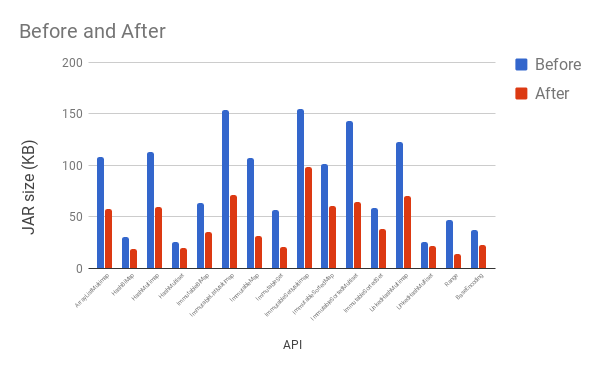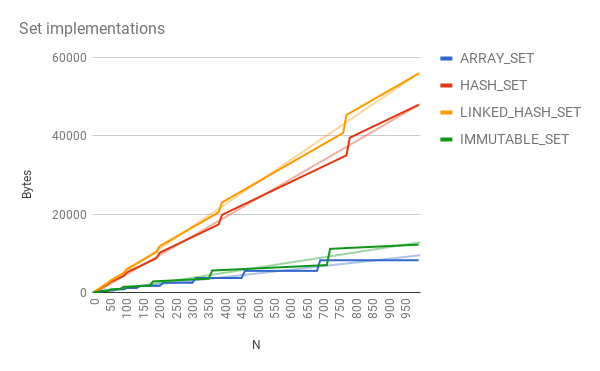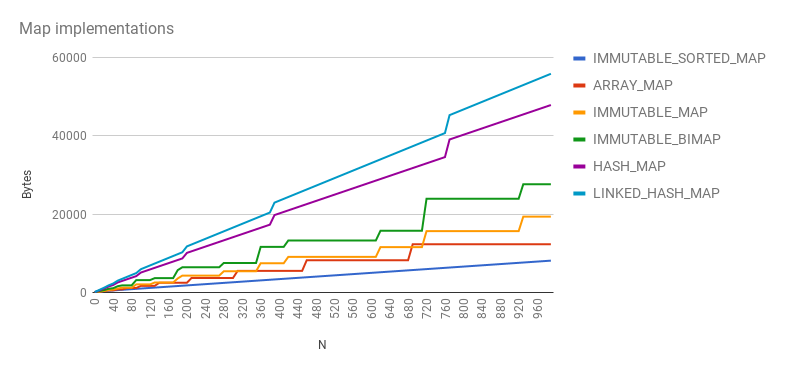-
Notifications
You must be signed in to change notification settings - Fork 10.9k
Android
Once upon a time, use of Guava was generally frowned upon in Android apps developed at Google, as Guava was designed, tested, benchmarked, and optimized for the conditions found in server Java development. This situation was suboptimal: Android developers found themselves reinventing wheels, awkwardly working around API gaps, and their best practices diverged from best practices for other Java development.
Over 2017, we worked extensively to change this situation: to optimize a branch of Guava for suitability for Android, in collaboration with Google's Android experts. We converged on the following set of priorities:
- Do not compromise on API design principles. Maintain API compatibility between the Android and mainline branches.
- Optimize for code size after applying ProGuard shrinking. Most Android apps need to prioritize APK size, but for apps where this is a concern, they should already be using ProGuard. For simplicity, we measured shrunk JAR size in bytes, classes, and methods, after applying Google's internal version of ProGuard, but most code shrinking tools should show similar results.
- Optimize for minimal allocation of objects and bytes. Garbage collection is often more expensive on Android.
- While some sacrifice to constant factors in CPU performance is tolerable, avoid asymptotic slowdowns.
As a result of this work, Google's internal Android best practices have gone from forbidding the use of Guava to actively recommending key parts of Guava.
Even after this work, not all of Guava is recommended for use on Android. We focused our optimization work on some key data structures and APIs. Loosely, we recommend against the following:
-
cache(preferLruCacheinstead) -
eventbus(uses reflection) -
reflect(uses reflection) -
graph(uses expensive data structures, usually not worth it) -
collect.Table(uses expensive data structures, usually not worth it)
This work consisted of lots of nitty gritty optimization work, but we can pick
out some high points. First, we made significant strides on reducing code size
footprint of many types, with most of that effort focused on common.collect.
The below chart shows the before and after JAR sizes of several key APIs, with
all measurements taken after appropriate ProGuard stripping.

We found many tricks for reducing code size, but the most important were
- removing unnecessary use of skeleton classes
- making it easier for ProGuard to eliminate dead code
- reducing static constants that could not be inlined, or moving them to helper classes
This work often went hand in hand with rewriting of underlying data structures,
especially in common.collect. Our primary goals for our data structures were:
- O(1) total objects in the “steady state” data structure (retained if you keep a reference to the collection itself)
- Asymptotics equivalent to the appropriate equivalent mutable data structures
(
LinkedHashMap, etc.) - Constant factors for memory consumption competitive with best-of-breed
Android data structures (
ArrayMap,ArraySet, even though those data structures gave up O(1) asymptotics) - Share objects where possible with the builder, to reduce garbage allocation
This required rewriting many of our core data structures in the Android fork,
especially requiring us to avoid entry objects wherever possible. For example,
ImmutableMap on Android is now backed by a flattened hash table built of
parallel arrays, with the hash table storing indexes into another array rather
than storing pointers to entry objects. Similarly, we developed algorithmic
tweaks allowing ImmutableSortedMap to sort the keys and values together
without combining them into Entry objects as would typically be required.
Generally speaking, we did not achieve data structures that were as compact as
Android's ArrayMap and ArraySet, but we came close while still providing the
O(1) asymptotics we expect from these structures.


Other data structures, unique to Guava, showed similar improvements even if they did not have competition. For example:
| Data structure | Bytes/entry (before) | Bytes/entry (after) |
|---|---|---|
HashBiMap |
64 | 40 |
HashMultiset |
59 | 24 |
LinkedHashMultiset |
67 | 32 |
We did, in some cases, accept asymptotic slowdowns to view collections where
workarounds were easily available. For example, few users know -- or care --
that ImmutableSet.asList() returned a "magical" ImmutableList with an O(1)
contains implementation. Eliminating the specialized implementation in the
Android branch allowed us to make significant code size savings, and the
workaround of just calling contains on the ImmutableSet directly is easy
enough.
- Introduction
- Basic Utilities
- Collections
- Graphs
- Caches
- Functional Idioms
- Concurrency
- Strings
- Networking
- Primitives
- Ranges
- I/O
- Hashing
- EventBus
- Math
- Reflection
- Releases
- Tips
- Glossary
- Mailing List
- Stack Overflow
- Android Overview
- Footprint of JDK/Guava data structures